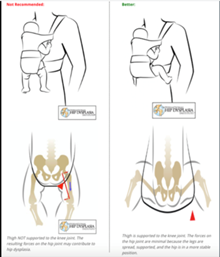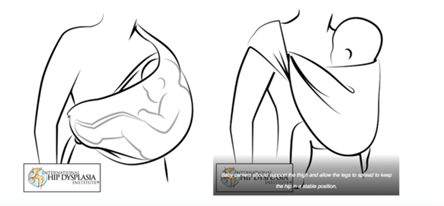Baby Wearing – Safety and Postural Considerations
Baby wearing is a common practice that involves carrying a baby close to your body using a carrier, wrap, or sling. In the last decade, baby wearing has become increasingly popular and has shown benefits including improved success with breastfeeding, improved infant to parent bonding, and improved attentiveness by fathers. Baby wearing has also been shown to improve spinal muscle activation and development compared to prolonged time in car seats or other baby containment devices.
Although there are many benefits to baby wearing, it is important to be aware of the risk of injury and negative physical effects that can occur with improper positioning.
Healthy hip position is one of the most important factors when considering positioning your baby in a wrap, carrier, or sling. When babies are in utero, they are tucked into the “fetal position” with hips and knees in a bent position. After birth, babies will continue to maintain this position until they gradually stretch during the first few months of life.
The hip socket is also shallow during infancy and the cartilage surrounding the hip is soft and flexible, similar to the cartilage of your ear. If the hips are forced into a straightened, overly stretched position too soon, a deformation of the edges of the hip socket can occur or the hip joint can slip out of the socket completely, causing a hip dislocation. Therefore, it is crucial to consider the position of your baby’s hips when carrying them for long periods of time.
The healthiest position for an infant’s hip is called the “M” or “frog” position. The infant’s hips and knees should be bent with the knees falling out to the side. The carrier should support underneath the baby’s thigh from knee to hip. The opposite of this position (legs straightened and held together) may increase the risk for hip dysplasia or dislocation. The image below shows the correct and incorrect position for your infant’s hips when using a baby carrier.

Along with hip position, it is important that young infants are always placed facing toward you. Babies are at increased risk for suffocation if not placed in a carrier correctly. The TICKS rule can assist with remembering how to safely position your baby in a carrier –
T – Tight. The carrier/wrap should be tight with no loose fabric and the baby well supported high on your body with head support
I – In view at all times. You should always be able to see your baby’s head and face when looking down
C – Close enough to kiss. You should be able to lower your head down and easily kiss the top of your baby’s head
K – Keep chin off chest. Ensure your baby’s chin is up and away from their body. If their chin is forced down onto their chest it can restrict breathing. Often, signs of distress in an infant are silent.
S – Supported head and back. Your baby’s back should be supported in a natural position with their stomach and chest against you. When bending over, support their back and head with your hand. If your child is under four months of age or does not have independent head control, the carrier/wrap should support their head.
Sling carriers (pictured below left) are not recommended for use in infants under 6 months due to the narrow position of the thighs. This style of carrier for infants also increases the risk of suffocation due to poor head and neck positioning. Infants should always be placed upright, as shown in the picture on the right.

It is also important to check your wrap/carrier/sling for appropriate height and weight information. Many manufacturers will have tutorials that will show you the proper way to put on and take off your wrap. The International Hip Dysplasia Institute has put out a list of baby carriers that have been deemed “hip healthy” which you can view by following this link: https://hipdysplasia.org/hip-healthy-products/
It is recommended to have someone assist you the first few times you use your wrap to ensure your safety and your baby’s safety. It is important to wear comfortable shoes and watch for tripping hazards as studies have shown an increase in infant injury when baby wearing, due to caregiver falls. If you have any concerns about utilizing certain wraps or carriers with your baby, reach out to your pediatrician or physical therapist at Kids Place for more information on baby wearing.
References:
Baby Carriers & Other Equipment – International Hip Dysplasia Institute. International Hip Dysplasia Institute. (2021, November 20). Retrieved January 15, 2023, from https://hipdysplasia.org/baby-carriers-other-equipment/
Siddicky, S. F., Bumpass, D. B., Krishnan, A., Tackett, S. A., McCarthy, R. E., & Mannen, E. M. (2020). Positioning and baby devices impact infant spinal muscle activity. Journal of Biomechanics, 104, 109741. https://doi.org/10.1016/j.jbiomech.2020.109741
Rowe, S. (2021, October 11). Baby-wearing products lead to higher risk of injury, hospitalizations in children under age 1. Home. Retrieved January 15, 2023, from https://www.aap.org/en/news-room/news-releases/aap/2021/baby-wearing-products-lead-to-higher-risk-of-injury-hospitalizations-in-children-under-age-1/
Baby carriers, slings and backpacks: Safety guide. Raising Children Network. (2022, December 22). Retrieved January 30, 2023, from https://raisingchildren.net.au/newborns/safety/equipment-furniture/baby-carrier-sling-safety
Dodwell, E. R. (2021). Babywearing is healthy, if done the right way. Hospital for Special Surgery. Retrieved January 15, 2023, from https://www.hss.edu/article_babywearing.asp







